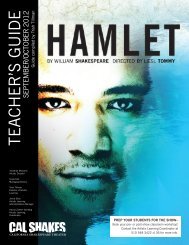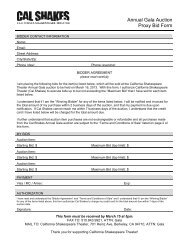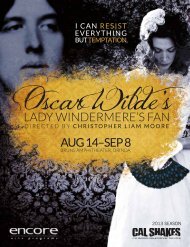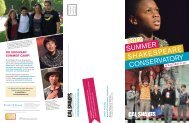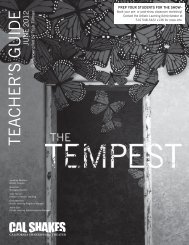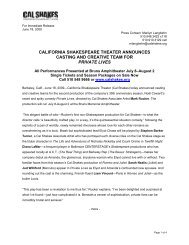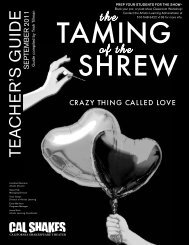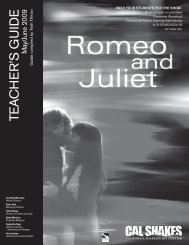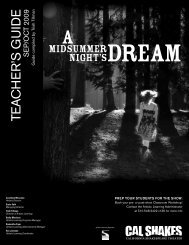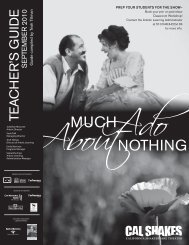Twelfth Night teacher's guide - California Shakespeare Theater
Twelfth Night teacher's guide - California Shakespeare Theater
Twelfth Night teacher's guide - California Shakespeare Theater
You also want an ePaper? Increase the reach of your titles
YUMPU automatically turns print PDFs into web optimized ePapers that Google loves.
People Pictures<br />
Overview: Participants will use pictures as inspiration in creating characters, and interact with others as their characters.<br />
They will try to determine which picture the other participants used for their inspiration after interacting with them.<br />
Grade: 3-8<br />
Goal: To literally be in someone else’s shoes, using the body and the voice to become that character.<br />
State Standards: English Comprehension & Analysis §2; Literary Response & Analysis §3; Listening & Speaking<br />
Applications §1, §2.<br />
Outcomes: Students will have a kinesthetic experience of being another person, will be able to imaginatively inhabit that<br />
person’s point of view, and have an expansive social experience within the imaginative boundaries of the game.<br />
Note: You might try this activity before you even begin discussing <strong>Twelfth</strong> <strong>Night</strong> and use pictures that are of the characters<br />
or very like the characters in the play. Without the initial burden of preconceived ideas about the text and the always-implied<br />
“great literature” shadow of <strong>Shakespeare</strong>, fresh discoveries about the personalities in the play might be made.<br />
Materials: Gather pictures of people, at least as many as there are participants.<br />
Notes on Pictures: Get a wide variety of people in settings and attitudes that lend themselves to the imagination. (It is<br />
better to not have celebrities the students will know.)<br />
Activity:<br />
Participants spread themselves out in the room, so that each person has enough space to think without distractions. The<br />
leader passes out a picture to each participant, explaining, “DO NOT let anyone else, even me, see your picture. You have<br />
three minutes to look at the person in your picture and become that person. Decide what kind of personality he or she has,<br />
how old the person is, what kind of life he or she leads, etc. Use the picture to help you decide—are there details about<br />
the person’s clothes, surroundings, or face which give you ideas? Try to create a “story” for this person, as well as a voice,<br />
mannerisms, attitude. All of your characters will attend a party at the end of the three minutes.” The participants should not<br />
talk to one another before the three minutes are up. At the end of the three minutes, the participants hand in their pictures.<br />
As soon as they hand in the picture, they transform into their character. The leader should explain that they need to talk to<br />
the other characters, as if they are at a party. The participants should attempt to talk to everyone else, and try to remember<br />
things about the other characters. The party lasts five to ten minutes, depending on the number of participants. At the<br />
end of this time, the leader asks everyone to discard their characters and become themselves. The leader then shows the<br />
participants the pictures that were used, and asks the group to identify whose character matches with the picture. (Don’t<br />
tell the participants that this will happen ahead of time. The temptation of “fooling” everyone is too great to resist for some<br />
people, and these people will purposefully make their character unlike their picture if they know there will be guessing.)<br />
Reflection:<br />
Start a discussion about the game with your students by asking the following:<br />
- How did you feel when you were being your character?<br />
- Did you find out more about your character by the way others treated you? What specifically?<br />
- Were you drawn to anyone at the party? Why?<br />
- Did you want to avoid certain people? Why?<br />
If your students have not read the play, you might want to write down their answers and save the pictures to connect to<br />
when you begin formal study of <strong>Twelfth</strong> <strong>Night</strong>. If your students are familiar with the play, you could ask:<br />
- Did any of these people at this party remind you of the characters in <strong>Twelfth</strong> <strong>Night</strong>?<br />
- Which character do you think you were?<br />
- Now that you have an idea of which character you were playing in this game, did you find out anything about him or<br />
her that surprised you? For instance, if you were Malvolio, did you find other parts to his character than just being rigid<br />
and judgmental?<br />
- Did the relationships that happened at the party mirror the relationships in the play or were they different?<br />
- Adapted from www.creativedrama.com<br />
PAGE 39



